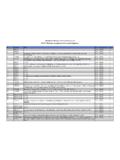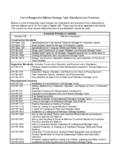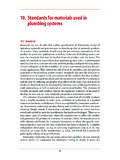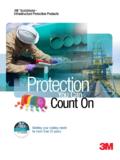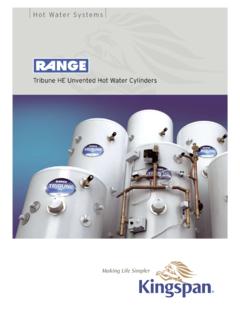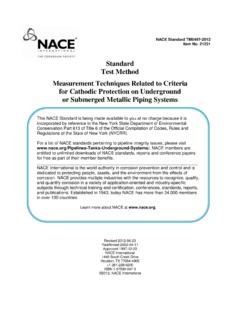Transcription of Five fatal flaws in API RP 581 - Corrosion Control
1 133-MS-20 five fatal flaws in API RP 581 Henk Helle BV The Hague, Netherlands ABSTRACT API RP 581: Risk-based Inspection Technology gives a methodology to implement Risk-based Inspection or RBI programs on fixed equipment and piping in the hydrocarbon and chemical process industries. The theory of RBI is described in API RP 580, which comprehensively lists the elements of risk caused by degradation of material, and the numerous possibilities to deal with these risks. RP 581 takes this outline one step further and describes how to qualify and quantify risks and how to plan and execute the inspection program. This methodology, however, is based on several flawed concepts or assumptions, notably: 1.
2 The concept of a generic failure frequency: probability of failure as an intrinsic property of all equipment. 2. The concept of a damage factor that multiplies the generic failure frequency, depending on configuration and conditions. 3. The concept to apply statistical theory as a prediction tool for failure. 4. The premise that certainty can rely on inspection alone. 5. The premise that a larger inspection program improves risk assessment. As a result of these flawed concepts, ineffective and inefficient inspection programs have ensued. This paper will examine these flaws and their effects, and propose alternatives. INTRODUCTION Risk is a term with a multitude of meanings ranging from the subjective to the mathematically exact.
3 The ISO 31000 / Guide 73 broad definition is effect of uncertainty on objectives which may be both positive or negative. Quantifying risk, both in absolute or relative sense, relies on the relationship: Risk is the product of the probability of an event times the consequence of the event . Used in an absolute sense this relationship produces a figure in the same units as those of the consequence -often a monetary unit - in the period of time considered, a year. In a relative sense, the equation can be used to judge the change of risk level. For instance, the effect of activities that change the probability of an event, or of measures that change the consequence of an event.
4 In risk management relative risk is an important guide. Risk in technology and engineering. In the process industries, risk invariably applies to failure or loss of functionality and considers the probability of such failure or malfunction, and its consequences. These risks are generally complex due to interactions of human factors and numerous technical variables on the probability side of the equation and 133-MS-20 14th Middle East Corrosion Conference & Exhibition Page 2 of 12 February 12-15, 2012 Manama, Kingdom of Bahrain the very broad range of possible outcomes involving health, environment and financial losses- on the consequence side. In some industrial environments semi- or fully quantitative methods, such as fault tree analysis or bowtie analysis are applied to determine risks.
5 In these methods, every step of conceptual failure scenarios are analyzed from start to finish and the probability and consequence of each path is considered. Naturally, the quality of the outcome of such analyses depends on the quality of the input data. Think, for instance, of the recent nuclear catastrophe at Fukushima. Flawed data or an inadequate scenario are by no means unique in quantitative risk assessment and can work both ways: from a severe overestimation of an identified risk, to being oblivious of a risk. The difficulty in assessing technological risks has created the concept of ALARP : As Low As Reasonably Practicable. A risk is ALARP at a point where the resources required to reduce the risk further are disproportionate to the benefit gained.
6 The ALARP principle recognizes the fact that it is not fruitful, or can even be counterproductive, to spend infinite amounts of time and money trying to reduce a small risk further. Common sense and engineering judgment are the main tools to strike a balance between a residual risk reduction and the price that society has to pay for that reduction. Probability of Failure The concept of failure in process units can have various meanings. From broad to narrow: 1. Failure by loss of integrity or compliance or fitness-for-purpose; when components lose legal or technical integrity, for instance due to cracking or loss of thickness. 2. Failure by loss of functionality; when a component in a unit no longer meets the performance standard.
7 3. Failure by loss of containment; when tanks or pressure containing parts are leaking or worse. This is in fact a special case of 2. Probability of failure by loss-of-containment is a vital part of risk assessment. In order to estimate the risk of events with grave or catastrophic consequences a credible assessment of the probability of the event must be available. This proves to be rather elusive: when the degradation processes and its potential rates are known, the probability of failure is rather low since the safe-life of the equipment can be assessed and monitored with considerable accuracy. In the opposite case, when degradation processes are not known and incidents go unnoticed, the probability of failure can be higher.
8 Vulnerability or susceptibility are concepts that can be used but need to be defined and quantified. These concepts often point to certain unintended dynamic aspects of the environment or the equipment, such as contaminations, starvation, enrichment processes, overheating, wear, unintended phase transformations or reactions, accumulation, overdosing, or fouling. Therefore, the value of probability of failure (PoF) is paradoxical and very difficult to quantify. Reason: the very moment one considers the issue for a given item, its value changes because causes, effects and remedies are being considered. Several methods to establish an objective value have been proposed: 1.
9 A quantitative standard PoF-value based on broad statistics 2. A quantitative specific PoF-value based on narrow statistics 3. A high-medium-low-negligible division based on a certain criteria. These criteria may: a. reflect the nominal corrosivity of the environment to the equipment 133-MS-20 14th Middle East Corrosion Conference & Exhibition Page 3 of 12 February 12-15, 2012 Manama, Kingdom of Bahrain b. assess the potential for extreme values of corrosivity. This approach includes off-design and what-if analysis. 4. Combinations of the above Compliance Corrosion engineering is a mature discipline. This means that the likely and the possible Corrosion mechanisms in any given process environment are known.
10 In the design of process plants these known threats are managed, which implies that integrity is assured in a process environment and equipment condition that are both compliant, meet the design and functional specifications. In case they are not compliant, departure from design degradation may occur. In developed process systems the effect of a certain degree of non-compliance is generally known and manageable. The situation can be different when the operator is unfamiliar with the process and the fact of or level of non-compliance are not obvious. Developed and compliant are subjective; what is mature for one operator may still be unfamiliar for another; demarcation between non-critical and critical non-compliance may be clear to one operator and less so to the next.

